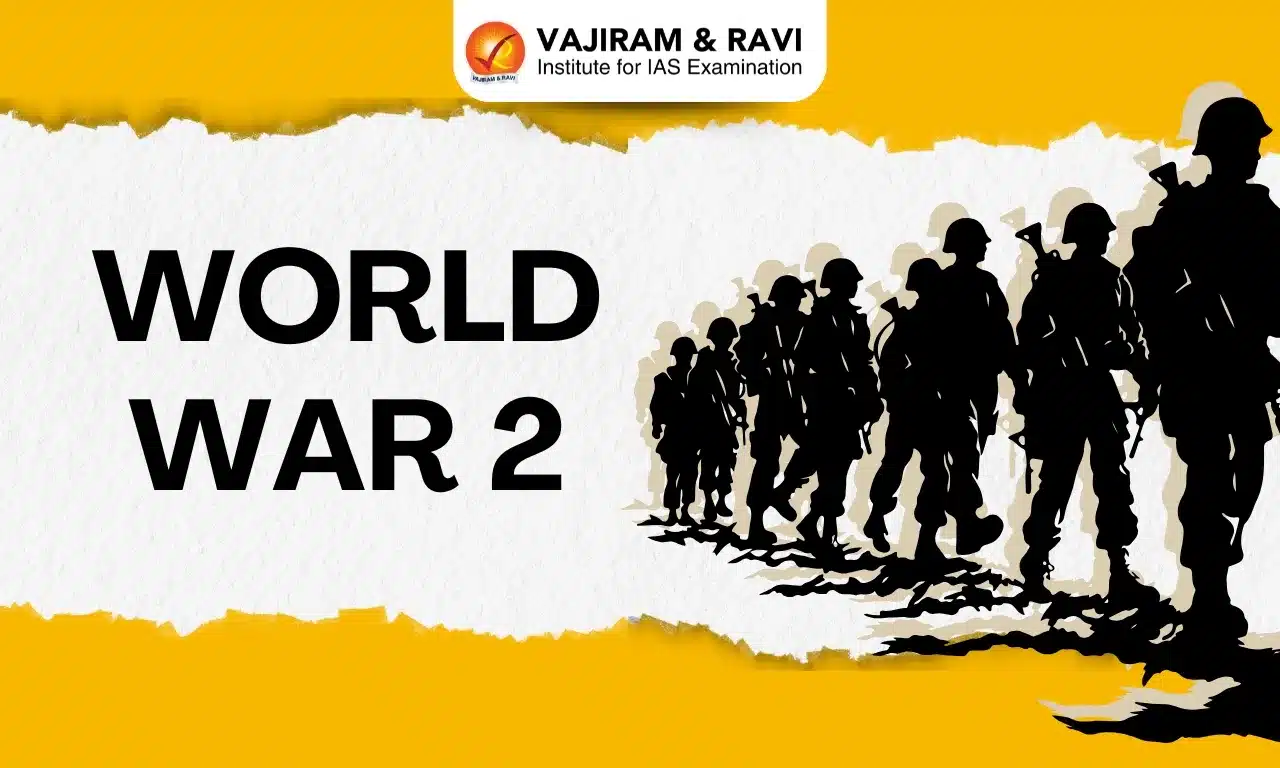World War 2 was a conflict that spanned almost the whole world from 1939 to 1945. The main adversaries were the Axis powers - Germany, Italy, and Japan; and the Allies- France, Great Britain, the United States, the Soviet Union, and, few other countries. The immediate cause for the war was the 1939 Nazi invasion of Poland among other factors. The war dragged on for six years until the Allies defeated the Axis powers in 1945.
The consequences of World War 2 were far-reaching, affecting every aspect of human life and reshaping the course of history. It altered the global landscape and changed the global map as well as resulting in the rise of the United States and the Soviet Union as superpowers and the start of the Cold War.
World War 2 Causes
World War 2 began in September 1939, following a German attack on Poland and the subsequent declaration of war by Britain and France against Germany. The Polish problem was the immediate cause of the Second World War, but numerous other factors contributed to the situation in which war became inevitable.
- Treaty of Versailles: The peace terms that were set out in the treaty afterWorld War I, were very harsh on Germany.
- Germany had to accept responsibility and pay reparations for the war.
- Germany lost territory and was barred from fielding a large military force.
- These were the reasons for the rise of an authoritarian leader in Germany - Adolf Hitler.
- He took Germany to the level where the war became an inevitable reality.
- After World War I, the victorious Allied Powers met to decide Germany's fate. The Treaty of Versailles would be forced upon Germany.
- Germany had to accept responsibility and pay reparations for the war. Germany lost territory and was barred from fielding a large military force.
- The Problem of National Minorities:
- Peace settlement after the First World War had resulted in the formation of new nation-states in Europe, with large national minorities left behind uncared for large German minorities found themselves in the company of non-Germans in Poland and Czechoslovakia. There were Russian minorities in Poland and Romania.
- Hitler exploited the situation in the name of denial of rights to German minorities in Czechoslovakia and Poland and prepared for aggression.
- Economic Depression (1929):
- The world experienced an economic depression in the late 1920s. During a depression, economies contract, trade declines, businesses close, prices decrease, banks fail, and unemployment rises.
- As the major global economies turned to protectionism, it caused the rise of authoritarian and totalitarian regimes in many countries like Italy and Japan.
- Failure of League of Nations:
- The League of Nations was established in 1919 to maintain global peace.
- The League of Nations proved to be a failure because all countries did not join the league and the League had no army to prevent military aggression such as Italy’s invasion of Ethiopia in Africa or Japan’s invasion of Manchuria in China.
- Aggression of Axis Powers:
- Japan’s aggression: The economic depression compelled Japan to invade the resource-rich region of Manchuria, China in 1931.
- Later, Japan captured Beijing and Shanghai in 1937.
- Further, Japan also captured Korea in 1931.
- Germany’s aggression: Hitler, promising to overturn the Treaty of Versailles and recapture the lost territories, quickly began militarizing Germany.
- He ordered German troops to enter the German-speaking Rhineland (France), Austria, and Czechoslovakia in 1936.
- Japan’s aggression: The economic depression compelled Japan to invade the resource-rich region of Manchuria, China in 1931.
- Italy’s aggression: In 1935, Italy invaded Ethiopia, and the League of Nations condemned Italy as an aggressor and put a ban on the sale of arms to Italy.
- Axis Treaty: In October 1936, Germany and Italy formally joined the Rome-Berlin Axis.
- In May 1939, Germany and Italy signed a military alliance called the ‘Pact of Steel'.
- Later, Japan joined them and on September 27, 1940, Germany, Italy, and Japan signed a Tripartite Pact at Berlin.
- Failure of Appeasement Policy:
- The British Government, led by PM Stanley Baldwin and Neville Chamberlain adopted a policy of appeasement towards Hitler.
- This was first, to counter the rise of France and later, to support Hitler who declared countering communists by signing the Anti-Comintern Pact in 1936 with Italy (later joined by Japan).
- The Pact was signed in March 1936, after Germany reconquered the Rhineland (administered by France since the Treaty of Versailles).
- France, too, started appeasing Germany.
- This was also evident in the Spanish Civil War of 1938
- This appeasement policy proved wrong for the Allied powers as Hitler started adopting the policy of aggression in reconquering Germany’s lost territories.
- Munich Conference: Italian leader Benito Mussolini persuaded the leaders of Britain, France, and Germany to meet at Munich.
- At the Munich Conference, it was agreed that Hitler could occupy the Sudetenland, a Czechoslovakian region bordering Germany, as long as Germany guaranteed they would take no further territory.
- In March 1939, Hitler broke the agreement and invaded the rest of Czechoslovakia.
- The appeasement policy became dead on moral grounds when Hitler attacked German Jews.
- But, Hitler continued his policy, signed a non-aggression pact (Molotov-Ribbentrop Pact) with the USSR in August 1939 and invaded Poland on 1 September 1939. This started World War 2.
World War 2 Phases
Britain and France had promised military assistance to Poland if attacked by Germany, therefore, the invasion of Poland became the immediate cause of the 2nd World War.
- Outbreak of the War:
- England and France declared war on Germany on September 3, 1939.
- On September 18, the Soviet Union invaded Poland, but Italy and the United States did not join the war for some time.
- Early triumphs: During 1939-41, Germany easily won many victories in Europe by adopting the “Blitzkrieg tactics”, or the ‘lightning war’, which was the speedy penetration by tank, followed by the Luftwaffe (air force).
- The German army conquered Poland in three weeks.
- By April 1940, the German forces conquered Norway and Denmark.
- In May, Belgium, Holland and Luxembourg were occupied.
- The invasion of France began on 12 May 1940. Mussolini too declared war on France and Paris fell undefended.
- Operation Sealion: The invasion of Britain, known as 'Operation Sea-Lion', was only achievable if the German force could cross the English Channel.
- In August 1940, the Luftwaffe launched a campaign over British skies. The British Air Force inflicted tremendous damage on the Luftwaffe. By November 1940 Operation Sea-Lion was indefinitely put off. Thus, it was a stalemate with Britain.
- After conquering Yugoslavia and Greece next, Hitler now turned to Russia.
- Operation Barbarossa: Hitler had always wanted to expand Germany eastwards to have Lebensraum or 'living space' for its people.
- Stalin too knew Hitler’s intentions but needed some time for rearmament.
- On 22 June 1941, Germany attacked Russia under Operation Barbarossa, without a formal declaration of war.
- The Soviet Union sought Allied assistance.A military pact was signed in July between Moscow and London.
- Germans occupied Leningrad in September and Ukraine in October 1941.
- But, the winter and reinforced Russian army left Moscow unoccupied and the Operation failed.
- Atlantic Conference: In August 1941, U.S. President Franklin D. Roosevelt and British PM Winston Churchill met in Newfoundland, to confer on a range of issues related to World War II.
- The Atlantic Charter was the result of the conference and It set the principles for post-war international reorganisation and the establishment of a “wider and permanent system of general security.”
- Birth of United Nations: Embodying these principles a Declaration of the United Nations was signed by all the anti-Axis powers on 1 January 1942.
- Entry of US: Since the outbreak of war, the U.S. had been sympathetic to Britain, allowing her to buy arms, first on a ‘Cash and carry’ basis and then on a ‘Lend-lease’ system.
- In November, Britain promised to attack Japan if the United States got involved in a conflict with that nation.
- The United States was forced to enter the war when Japan attacked its naval base in Pearl Harbour on 6 December 1941.
- Italy and Germany both proclaimed war on the United States on December 11.
- The war thus became global, a world war.
- Battle of Stalingrad: By November 1942, the German army were in and around Stalingrad, but they were encircled by the Soviet troops.
- The Russian winter again took its toll and by January 31, 1943, the German army had collapsed.
- This was the fatal blow to Hitler.
- The majority of Ukraine and other regions of the Soviet Union were liberated from the Axis forces by March 1944.
- Defeat of Italy: In 1943 the Allied powers decided to launch an attack against the Axis by liquidating the Italian Empire in Africa. This objective was achieved by May 1943.
- Soon, Operation Husky was launched and Sicily too was occupied.
- Italy surrendered unconditionally on September 3, 1943.
- Yalta Conference: At the Yalta Conference in February 1945, the last offensive against Germany was outlined.
- The Americans, Canadians, French, and British launched an all-out offensive against Germany.
- Defeat of Germany: The Allies quickly regained the lost territories from Germany and soon surrounded Berlin. Hitler committed suicide on April 30, 1945.
- Finally, on May 7, the Doenitz Government (of Germany) surrendered unconditionally "all land, sea, and air forces of the Reich". The war in Europe was over on May 8, 1945.
- The Potsdam Conference, 1945: The Big Three - Joseph Stalin, Winston Churchill (replaced on July 26 by Prime Minister Clement Attlee), and Harry Truman met in Potsdam, Germany, from July 17 to August 2, 1945, to make important decisions regarding a formal treaty of peace.
- It was decided that Germany would be disarmed and that the Nazi organisation and its laws would be abolished.
- The war criminals were to be tried (later, Nuremberg trials). Finally, a democratic government would be established in Germany.
- Defeat of Japan:
- Japan entered World War 2 with the invasion of French Indochina on September 22, 1940.
- Consequently, it captured Southeast Asian regions from the Allied powers. Manchuria and Korea had already been captured.
- It dragged the US to World War 2.
- In July 1945, the Potsdam Conference gave a call to Japan regarding the unconditional surrenderwhich it ignored and continued to fight.
- On August 6, 1945, the American Air Force dropped the first-ever atomic bomb on Hiroshima.
- Two days later the Soviet Union declared war on Japan.
- Another bomb was dropped on Nagasaki on August 9, 1945, unleashing unprecedented devastation. The following day, Japan sued for peace.
- Fighting ceased but surrender documents were signed only on September 2, 1945, on board theUS battleship Missouri.
The second world war finally ended with Japan’s defeat.
Second World War Consequences
The outcome of the war was the defeat of the Axis powers and the victory of the Allies. This also signified the triumph of democracy and the demise of Fascism and dictatorship. Following are the consequences of the War.
- Devastating End of the War:By the end of 2nd World War, much of Europe and Asia, and parts of Africa, lay in ruins.
- The war claimed a startling number of military and civilian fatalities.
- The war resulted in the total demolition of Hiroshima and Nagasaki.
- Change in Global Order:The old imperial powers like Britain and France lost their importance post World War 2.
- The United States (US) became the leader of the "free world" or democracy.
- The Soviet Union had grown more dominant in the Eastern half of Europe with the defeat of Germany.
- Economic Hardships: By 1945, war-exhausted countries faced severe economic problems such as inflation, debt, trade deficits, the balance of payments deficits, depleted gold and dollar supplies, etc.
- In 1948, US President Truman signed the Economic Recovery Act of 1948 (the Marshall Plan). It recommended that the United States provide economic help to repair Europe's postwar economic infrastructure.
- Nuclear Arms Race: The use of atomic weapons during World War II marked the beginning of the atomic age.
- International efforts to restrict the development of nuclear technology swiftly failed, resulting in a race between the countries to build their own nuclear weapons.
- Beginning of Cold War: Following the defeat of the Axis forces, an ideological and political competition between the United States and the Soviet Union led to the outbreak of the Cold War.
Role of Indians in the World War 2
As with the First World War, Britain called for Indian soldiers to assist in the war effort.
- Largest Volunteers Army: The size of the British Indian army at its peak reached 2.5 million – making it the largest volunteer army in the world. Approximately 89,000 Indian soldiers died fighting for the Empire.
- Fought on all major fronts: The Indian army was deployed for war in Europe, Africa, the Middle East, and Southeast Asia.
- Indian troops played a significant role in liberating Italy from Nazi Germany in the Battle of Monte Cassino.
- Major Supplier of War: The Indian subcontinent became a vast supply ground for the war against the Japanese in Southeast Asia.
- Hundreds of its new factories maintained regular supplies of textiles and other war-related materials to all the Allied countries.
- Impact on India: The Second World War had a huge impact on India.
- By the end of the Second World War, Britain's place in the world had changed dramatically and the demand for independence could no longer be ignored.
- Subhas Chandra Bose raised the INA, consisting of Indian soldiers and prisoners of war (POWs) of Japanese in Southeast Asia, to fight and overthrow the British rule in India.
- After the war, the British Colonial government planned to try the surviving members of the INA for treason which resulted in a new wave of nationalism.
- The war resulted in the rise in taxes, inflation, corruption and famines. The most devastating famine in India was during World War 2, in 1943.
World War 2 UPSC PYQs
Question 1: To what extent can Germany be held responsible for causing the two World Wars? Discuss critically(UPSC Mains 2015)
Last updated on November, 2025
→ Check out the latest UPSC Syllabus 2026 here.
→ Join Vajiram & Ravi’s Interview Guidance Programme for expert help to crack your final UPSC stage.
→ UPSC Mains Result 2025 is now out.
→ UPSC Notification 2026 is scheduled to be released on January 14, 2026.
→ UPSC Calendar 2026 is released on 15th May, 2025.
→ The UPSC Vacancy 2025 were released 1129, out of which 979 were for UPSC CSE and remaining 150 are for UPSC IFoS.
→ UPSC Prelims 2026 will be conducted on 24th May, 2026 & UPSC Mains 2026 will be conducted on 21st August 2026.
→ The UPSC Selection Process is of 3 stages-Prelims, Mains and Interview.
→ UPSC Result 2024 is released with latest UPSC Marksheet 2024. Check Now!
→ UPSC Prelims Result 2025 is out now for the CSE held on 25 May 2025.
→ UPSC Toppers List 2024 is released now. Shakti Dubey is UPSC AIR 1 2024 Topper.
→ UPSC Prelims Question Paper 2025 and Unofficial Prelims Answer Key 2025 are available now.
→ UPSC Mains Question Paper 2025 is out for Essay, GS 1, 2, 3 & GS 4.
→ UPSC Mains Indian Language Question Paper 2025 is now out.
→ UPSC Mains Optional Question Paper 2025 is now out.
→ Also check Best IAS Coaching in Delhi
Second World War FAQs
Q1. Who fought in World War 2?+
Q2. When did World War 2 start?+
Q3. When did the Second World War end?+
Q4. When did the United States enter World War 2?+
Tags: quest world war 2

















